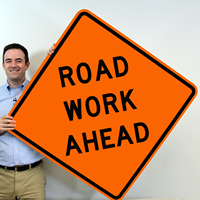
To ensure that motorists and pedestrians are protected as much as possible from the hazards of road work sites, Road Work Signs are installed to forewarn road users of conditions along the way. These signs advise drivers and pedestrians to practice caution, and may also serve to direct traffic to an alternate route. Temporary in nature, these signs are used only up until road work is completed.
MUTCD requires the use of diamond-shaped signs with a black legend and orange background to designate construction, maintenance, and utility work zones. As a rule, Road Work Signs must be located on the right side of the roadway. Usually, the first advance warning used is Road Work Ahead or Utility Work Ahead. Towards the end of a work zone, signs such as ‘End Road Work’ or ‘End Utility Work’ are commonly seen.
When are Road Work Signs used?
Below are just a few instances in which the installation Road Work Signs are required-
1. Work Performed On The Roadside (Outside Shoulder)
When vehicles use the road’s shoulder to pass through the construction site, a sign that says “Shoulder Work” is used. Mowing operations must be accompanied by a “Mowing Ahead” sign, which must be installed every 2 miles for projects that extend over a distance exceeding 2 miles. A supplementary plate with the “Next X miles” may be positioned below the initial warning sign.
2. Work Performed On Shoulders
When the shoulder is not in use but the work going on there has impacted its condition, a sign such as “Low Shoulder Sign” or “Soft Shoulder Sign” is used. The sign should be placed at every 1-mile interval when the condition spreads over a distance greater than a mile. A supplementary plate as mentioned above may be used in this case as well.
3.Closed Lanes on Multi-Lane Roads
What are the types of Road Work Signs used?
Some of the Road Work Signs that may appear along work sites are:
- Road (Street) Work Sign – This sign is placed in advance of the work site or detour, and used to warn oncoming traffic of road restrictions and obstructions. The legend “Road (Street) Work ‘X’ Ft” or “Road (Street) Work ‘X’ Mile” is used in such signs.
- One-Lane Road Sign – This sign is used in cases of temporarily merged lanes, and is supplemented by another with distance in feet or miles. This second one may say “One Lane Road ‘X’ Feet” or “One Lane Road ‘X’ Miles.” A One-Lane Road Sign can be used with other warning signs where necessary.
In cases where the changes to a lane are visible only from one side or traffic direction, or when traffic is such that it moves simultaneously at both ends frequently, flagging procedures or control may be used.
The word “Flagger” with a note on his/her exact distance may be used in place of a Flagger Symbol Sign. When the flagger is not stationed at his/her place, the sign is turned to face away from the oncoming traffic.
- Road Machinery Sign – This sign is used to alert traffic that heavy machinery or equipment is being used in or next to the road.
– V. Makharia